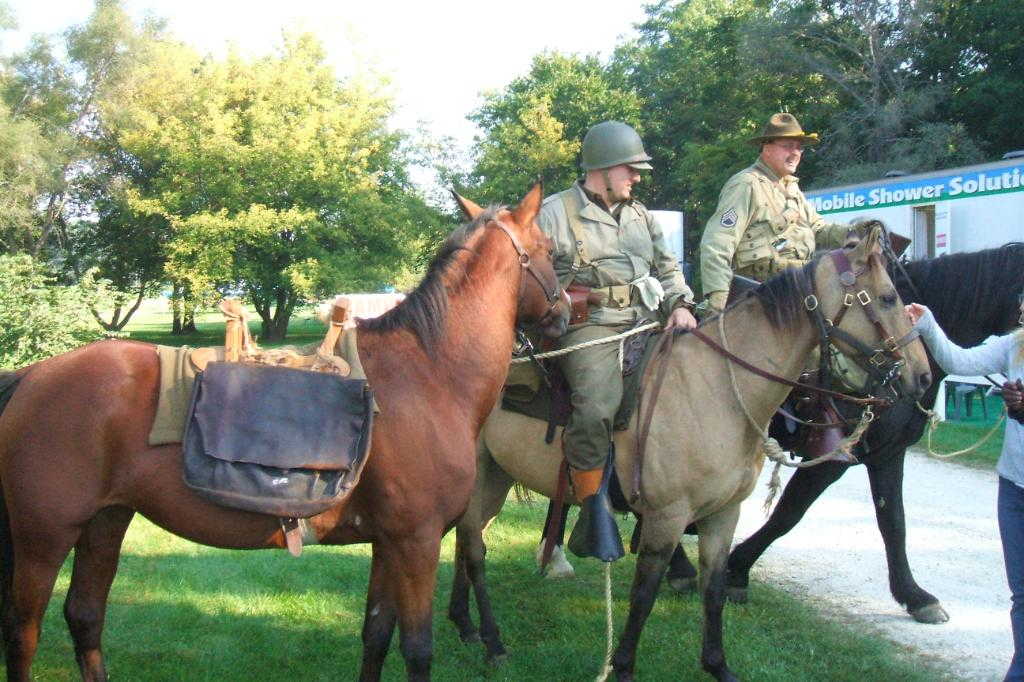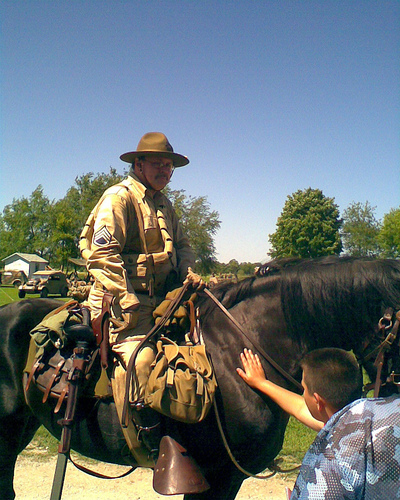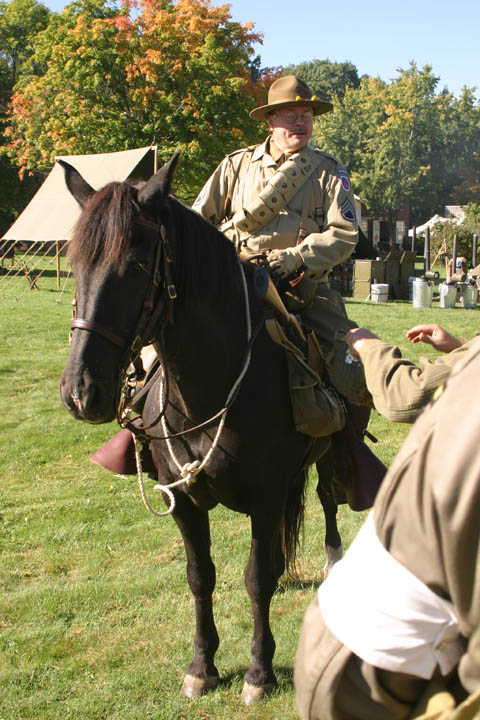
10th
Mountain Division
Mounted Recon Troop
The northern Illinois 10th Mountain
Division re-enacting group also provides a unique opportunity for mounted
re-enactors to interpret a U. S. mounted WW2 impression. The division had a
Mounted Reconnaissance Troop, which saw action with the division in northern
Italy in 1945; which we interpret in living history, educational and combat
scenarios.

BACKGROUND.....
The 10th Mountain trained at Camp
Hale, CO with a mounted recon troop, envisioning a combination of horses and
snowshoes for winter conditions recon. The concept was, however, abandoned as
not being tactically viable; and the mounted troops were transferred to other
roles throughout the division.
However, upon the 10th’s arrival in
Italy in 1944, it became obvious that mounted recon could actually be very
useful in northern Italy’s rugged terrain. Horses would be able to get to places
where mechanized vehicles could not. Drawing upon the resource of
previously-trained hordes cavalrymen still in service, volunteers were recruited
in order to reconstitute the mounted recon troop. The troopers were transported
to the MTO, where they drew pack transportation saddles and tack, and Italian
horses.
In early April of 1945, the mounted recon
troop had the honor of serving as the vanguard for 5th Army’s Po
River offensive, their last one of the war. In fact they actually engaged German
troops on at least one occasion, even charging a machine gun position with a
platoon-sized mounted pistol charge! So much for the belief that U. S. mounted
ops ended with the fall of the Philippines in the spring of 1942!
Click here for a short
chronology of the Recon Troop

ABOUT THE TROOP.....
The mounted recon troop is a sub-unit of the
northern Illinois 10th Mountain Division re-enactment group. The
troop commander is SSgt. Ward Brown, a re-enactor with over 20 years experience
as a “pony soldier”. The mounted troop has built an experienced and skilled
cadre, but seeks additional experienced riders who are willing and able to
authentically portray the impression.
Although the ad hoc nature of the
reconstituted troop allows a certain amount of flexibility in uniforms and
equipment, there will still be an overall focus on portraying a proper military
impression. Troopers will need to have an authentic version of the McClellan
saddle (models 1904, 1928 or 1913 pack are acceptable), along with the
appropriate tack. A long arm (M1 Garand, M1 Carbine or 1903 Springfield) will be
needed, along with a scabbard with which to carry it. Also, an appropriate
blank-firing sidearm (1911 Colt “.45 Auto” or time-correct issue revolvers)),
holster and 9-pocket mounted cartridge belt will be needed.
Uniforms for the mounted troop will be
somewhat flexible, allowing U. S. combat uniforms and equipment, generally.
However, leather mounted (sometimes used by ABN) gloves are recommended. Also,
mounted uniform items, such as the cavalry breeches and the M1941 3-buckle
mounted boots, may be worn.
MOUNTED TROOP
INFORMATION.
Contact Ward for
information and questions
at 630-408-0943.
Story of the "Last
Charge"!
From "Packs On" Memoirs of
the 10th Mountain Division in WW2 by A. B. Feuer. Pages 39 and
40.
The strangest organization attached to the 10th Mountain was the
Cavalry Reconnaissance Troop. The unit was originally formed at
Ft. Meade, South Dakota, as a horse cavalry outfit.
In November 1942 the troop was sent to Camp Hale Colorado for
winter training. It was hoped that the men might be able to
maneuver equally on horses and skis. However, this was not the
case. Consequently officers and men of the troop were split up
among various quartermaster companies. They were then replaced
by expert mountaineers and the horses were replaced with
mechanized equipment. The troops mission was also changed. The
men became instructors, teaching rock climbing to the 10th
Mountain Soldiers at Camp Hale and glacier techniques at Mount
Ranier, Washington.
In the autumn of 1944, the Cavalry Reconnaissance Troop was
re-activated at Camp Swift Texas and soldiers with horse
experience were transferred into the outfit.
Donald Hubbard recalls his experiences with the Horse
Cavalry in Italy
"After arriving at Naples, we moved inland and were billeted
at San Marcello. We received Jeeps (no horses yet) and began
reconnaissance patrols into the mountains and high ground
occupied by the Germans.
In the spring, we were trucked to Florence where we would
finally receive our mounts. This good news lifted our spirits
and gave us something different to talk about, such as what
their color might be or their size, age, and temperment.
Our first look at the horses, however, was somewhat
disappointing as they seemed very docile. We learned that they
had been obtained from the French, Sardinians, Hungarians and
Germans. A two day ride to the front revealed that our
evaluation of the horses was correct. But then maybe it was
better to have mounts that were easy to control, especially
under fire.
On April 14, 1945 the Po River valley campaign began with the
10th heading the attack. The division rushed ahead so fast that
the enemy was unable to establish an effective defense.
As mounted cavalrymen, we still didn't have riding boots or
spurs but that didn't deter us. Our horses stood up well to the
attack, but they often lacked the correct diet. The Italian
people however often came to the rescue with whatever food they
could spare.
Our objectives were not always clear, but part of the confusion
was due to the large number of Germans who were surrendering.
Our instructions were to send the prisoners to the rear. Other
orders were to bypass pockets of resistance. It was at one of
these so-called pockets of resistance that the Cavalry
Reconnaissance Troop fought one of the strangest battles of the
war. We had advanced within a few kilometers of the Po River
when we came upon a small Italian Village. The troop was moving
in formation, single file with the First Platoon in the lead.
There were buildings on a side street to our left, giving us a
choice of either going straight ahead or turning left and
passing in front of the buildings.
The Decision was quickly made for us. German machine guns on the
second floor of a stone dwelling opened fire on our troops. The
Third Platoon commander ordered a pistol charge on the enemy
position, but some of his men were unarmed. The First and Second
Platoons dismounted and prepared to support the assault. What
the Third Platoon lacked in firepower was more than made up for
by its overabundance of courage. Our supporting volleys were
able to suppress the enemy guns, giving the Third Platoon a
chance to recover and withdraw. The pistol charge was
un-successful but ended without casualties to men or horses.
The use of horses in this campaign ended when we reached the Po
River at San Benedetto. We tied our horses in an orchard of
fruit trees, bid them farewell, and crossed the river in boats."
|
|
|
|



